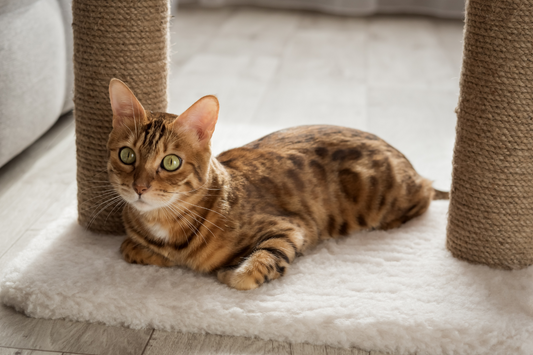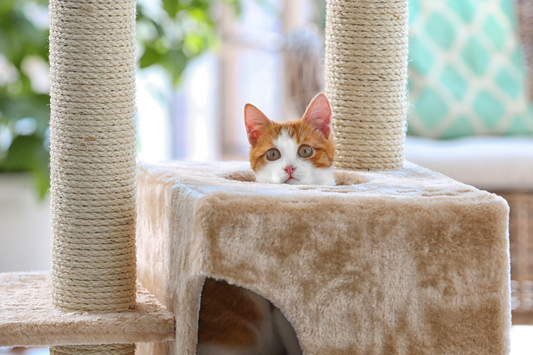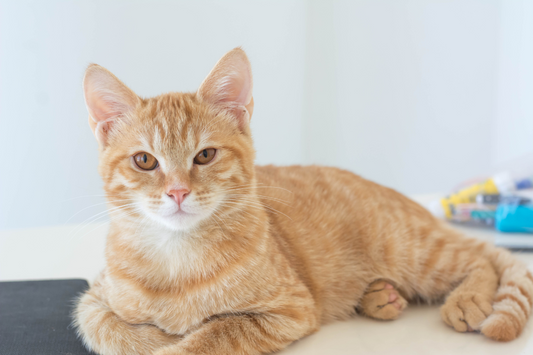
Scratching is as natural to cats as purring or chasing a toy mouse. It’s not mischief—it’s a deeply ingrained behavior that supports their health, stress relief, and communication. For cat owners, the question isn't if you need a scratcher, but how many cat scratchers does a household need? The answer depends on your home setup, the number of feline residents, and your cat’s scratching preferences.
Why Cats Need Scratchers: Instincts, Health & Happiness
Cats scratch for several reasons: to remove dead outer layers from their claws, to mark territory with scent glands in their paws, to stretch their bodies, and to relieve stress. A lack of appropriate outlets for this behavior often leads to scratched furniture, doors, or even walls. Providing dedicated scratchers not only protects your home it also promotes physical and emotional well-being in your cat.
A well-placed scratcher encourages healthy movement and claw maintenance while offering a sense of control over their environment. It’s a simple yet powerful way to meet a basic feline need.
The Golden Rule: One Per Cat, Plus One Extra
A widely accepted guideline among veterinarians and behaviorists is this: have at least one scratcher per cat, plus one additional. This ensures that each cat can claim a scratcher without feeling the need to compete, especially in multi-cat households.
For instance:
1. One cat = two scratchers
2. Two cats = three scratchers
3. Three cats = four (or more)
Even in single-cat homes, having multiple scratching options in different locations is beneficial. Cats prefer to scratch in specific contexts—after waking up, near feeding spots, or in social areas. A single scratcher hidden in a corner may not get the use you’re hoping for.
Placement Is Everything: Think Like a Cat
Where you place scratchers matters just as much as how many you provide. Cats tend to scratch in high-traffic zones and near places they frequent most, like resting spots, windows, and doorways. Scratching is partly territorial, so areas they walk through or patrol regularly are prime real estate.
Start by placing a scratcher:
1. Near your cat’s favorite sleeping spot
2. In the living room or wherever the family gathers
3. Close to areas where they’ve scratched furniture before
By matching placement with natural feline behavior, you’re guiding your cat to make better scratching choices.
Vertical, Horizontal, and More: Why Variety Matters
Not all cats like the same scratching surfaces. Some prefer vertical posts to stretch tall, while others enjoy horizontal pads to scratch low and lounge. Texture also matters—cardboard, sisal, carpet, or wood can all appeal differently.
If you’re unsure what your cat prefers, offer a mix:
1. A tall sisal-covered post for full-body stretches
2. A flat cardboard pad near windows
3. A sloped ramp-style scratcher in a hallway
Providing multiple types increases engagement and prevents boredom. Plus, different designs suit different rooms and decor styles, making it easier to blend them into your home.
Multi-Cat Homes: Creating Scratching Harmony
In households with more than one cat, tension over territory can lead to over-scratching, furniture damage, or even fights. Multiple well-placed scratchers help diffuse conflict by giving each cat their own space to mark and unwind.
To prevent resource guarding, avoid clustering all the scratchers in one area. Spread them throughout the home—one in the living room, another in the hallway, and one in a bedroom or quiet corner. This encourages peaceful coexistence and allows each cat to establish their personal zones.
Keep an eye on interactions. If one cat is monopolizing a scratcher or guarding it from others, it’s a sign you need to add more and space them further apart.
When to Add or Replace a Scratcher
Even the best scratchers have a lifespan. Over time, cardboard layers tear, sisal rope frays, and wooden bases weaken. If a scratcher looks worn, wobbly, or stops attracting your cat, it’s time to replace or upgrade.
Some signs your cat may need a new scratcher:
1. They’ve gone back to scratching furniture
2. The post wobbles or topples over
3. They sniff it and walk away
4. The material is shredded or falling apart
Regularly rotating in fresh scratchers can reinvigorate your cat’s interest and prevent damage to other parts of your home. And if you’re introducing a new cat, consider replacing old scratchers to remove scent markers and reduce stress.
Final Thoughts: A Scratch-Worthy Investment
So, how many cat scratchers does a household need? At a minimum, follow the “one-per-cat-plus-one” rule—but always consider your space, your cat’s preferences, and their behavior. Scratchers are more than just accessories; they’re essential tools for creating a feline-friendly environment.
By providing variety, proper placement, and adequate quantity, you’re not just protecting your furniture—you’re enriching your cat’s life. A happy scratching cat is a healthier, calmer, and more confident companion.











